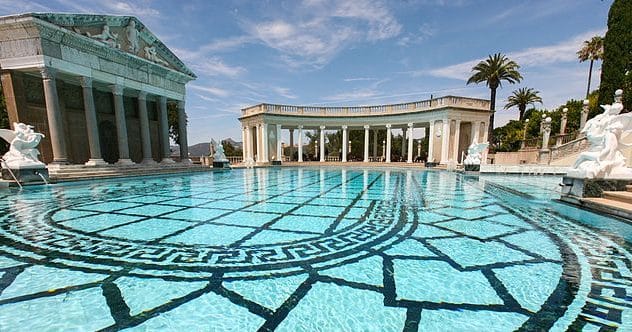History is filled with tales of the wealthy and powerful. While many are known for their good deeds, there’s a fascinating side to extreme wealth: the drive to outdo one another. These aren’t just friendly rivalries; they’re battles of ego, extravagance, and sometimes, pure spite. From palatial homes to priceless jewels and beyond, the desire to be on top has led to some truly unbelievable stories. Get ready to dive into 10 instances where the ultra-rich engaged in high-stakes games of one-upmanship.
10. Alice and Alva Vanderbilt: The Cottage Wars
Family competition can be intense, but the rivalry between sisters-in-law Alice Claypoole Vanderbilt and Alva Vanderbilt reached legendary status. During the late 19th century, these two society figures engaged in a spectacular contest to build the most magnificent summer homes in Newport, Rhode Island. Though called “cottages,” these structures were more akin to European palaces.
Alva’s Marble House, designed by architect Richard Morris Hunt and completed between 1888 and 1892, was a marvel of opulence, reportedly inspired by the Petit Trianon at Versailles. However, Alice seemed determined to have the last word. She enlisted the same architect, Hunt, to create The Breakers. This colossal 70-room, five-story mansion spanned 62,482 square feet, constructed with marble and steel, and offered breathtaking views of Easton Bay. Both homes remain iconic symbols of the Gilded Age and a testament to this lavish family feud.
9. Richard Burton Outbids Aristotle Onassis: Diamond Duel
Actor Richard Burton and Greek shipping magnate Aristotle Onassis shared more than just fame; they both enjoyed extravagant lifestyles, famous partners, and spending vast sums on jewels. This shared taste led to a legendary bidding war.
Burton had already purchased the 33.19-carat Krupp diamond for his wife, Elizabeth Taylor. When a stunning 69.42-carat pear-shaped diamond became available, both men wanted it. Onassis was shopping for his wife, Jacqueline Kennedy Onassis, for her 40th birthday and sought a diamond of at least 40 carats. At the tense 1969 auction, Onassis bowed out at $700,000. The battle came down to Burton’s representative (capped at $1 million) and Robert Kenmore of Kenmore Corporation, owner of Cartier Jewelers. Kenmore secured the diamond for $1,050,000. But Burton wasn’t defeated; he swiftly bought the stone from Cartier for $1.1 million, christening it the Taylor-Burton Diamond.
8. Gloria Guinness vs. Babe Paley: The Socialite Smackdown
Babe Paley and Gloria Guinness were two of the 20th century’s most celebrated socialites and key members of Truman Capote’s inner circle of glamorous friends, dubbed “swans.” Despite their association, a bitter rivalry simmered between them.
Paley often tried to undermine Guinness by highlighting her less glamorous past as a nightclub worker in Mexico. Guinness, however, was a formidable opponent. She masterfully upstaged Paley during a shared vacation on the Guinness yacht. Gloria cunningly advised Babe to pack only casual attire. Then, on their first evening, Gloria appeared adorned in dazzling jewels and luxurious fabrics, insisting the party attend a formal dinner, leaving Paley feeling embarrassingly underdressed.
7. Katy Perry’s Pricey Bid for Orlando Bloom
It’s not every day that outspending someone serves a charitable cause, but pop star Katy Perry did just that in 2018. At a charity auction to raise funds for Malibu’s recovery from devastating wildfires, Perry paid $50,000 for a date with Orlando Bloom.
Initially, Perry was on stage helping to auction off the lunch date with Bloom. However, she apparently had a change of heart when another woman bid $20,000. The amusing twist? Perry and Bloom were already dating at the time. It seems she was willing to pay a premium to ensure no one else got a date with her man, all while supporting a good cause.
6. Battle of the Skyscrapers: The Race to the Sky
A fierce architectural rivalry dubbed “The Race into the Sky” unfolded in New York City. Architect H. Craig Severance, commissioned by banker George Ohrstrom, competed against William Van Alen, who was designing the Chrysler Corporation’s headquarters. Their goal: to build the world’s tallest building. This wasn’t merely professional; the two were former business partners with a bitter history.
Severance was so driven to beat Van Alen that he added two extra stories to his original plans, and later another 65 feet, making his 62-floor building the tallest. But his victory was fleeting. Van Alen had a secret weapon: a 125-foot spire, secretly assembled and hoisted to the top of the 808-foot Chrysler Building, clinching the title. Ironically, their triumph was short-lived. Just a year later, in May 1931, the 1,250-foot Empire State Building surpassed them both.
5. The Tobacco Heiress vs. The Dime Store Heiress: A Fortune Feud
Doris Duke, heiress to a tobacco fortune, and Barbara Hutton, who inherited wealth from Woolworth’s five-and-dime stores, were among the richest women globally. Their extravagant lives were media sensations from the 1930s onwards. Initially friends, they became staunch rivals, often competing for the same men.
This rivalry saw Duke flirt with Hutton’s ex-husband, Cary Grant. Hutton retaliated by marrying Duke’s former spouse, Porfirio “Rubi” Rubirosa, a Dominican diplomat and noted playboy. In a particularly brazen move, Hutton tried to lure Duke’s jazz musician boyfriend, Joe Castro, with a lavish offer. She reportedly called him, saying, “I’d give you more than she would. If you were with me, you’d have a symphony orchestra.”
4. Duke vs. Hutton Round Two: The Hawaiian Redecoration
During a rare period of truce, Doris Duke invited Barbara Hutton to her Hawaiian home. Hutton, accustomed to getting her way, proved to be a less-than-ideal guest. She disliked the existing furnishings.
Instead of simply offering decorator suggestions, Hutton took advantage of Duke’s absence. She had Duke’s furniture, which included priceless Asian art, removed and replaced it all with modern Japanese décor. Upon returning home and discovering the unauthorized renovation, Duke was furious and promptly kicked Hutton out, reigniting their famous feud.
3. Andrew Carnegie and John D. Rockefeller: Titans at Odds
Steel magnate Andrew Carnegie and oil baron John D. Rockefeller shared a long and complex rivalry. For Carnegie, it was partly fueled by a desire for revenge. He blamed Rockefeller for the 1873 financial crash that severely impacted his primary customers, the railroads. Carnegie also held Rockefeller responsible for the death of his mentor, Thomas Scott, who passed away a few years after the crash.
Carnegie aimed to surpass Rockefeller’s fortune and become the world’s richest man. To achieve this, he partnered with the ruthless Henry Clay Frick, who aggressively expanded their steel company by acquiring competitors. However, Frick’s reckless actions linked to an exclusive club led to the tragic 1889 Johnstown Flood, which killed over 2,200 people. This disaster deeply affected Carnegie, prompting him to re-evaluate his relentless pursuit of wealth. He shifted his focus to the extensive philanthropy for which he is now celebrated, moving away from greed and vengeance.
2. The Vanderbilts Crash High Society’s Gates
In old New York, the Vanderbilts, who amassed their fortune through railroads, were once considered “new money” and snubbed by the established elite, led by Mrs. Astor. This exclusion was particularly irksome to the socially ambitious Alva Vanderbilt. What the family lacked in lineage, they compensated for with sheer extravagance.
The turning point came with Alva’s legendary costume ball on March 26, 1883, a housewarming for her and Cornelius’s French chateau-inspired New York townhouse. Mrs. Astor’s own daughter desperately wanted an invitation. The ball was an affair of unparalleled opulence. Guests donned custom-made costumes, appearing as historical and mythical figures. The Fifth Avenue ballroom was transformed into a “fairyland” with countless roses, gold, and silver decorations. The Vanderbilts spent $65,000 on champagne, catering, and cigars alone—the total cost was $240,000, roughly $7 million today. To secure her daughter’s entry, Mrs. Astor finally relented and left her calling card at the Vanderbilt residence, signaling their acceptance into high society.
1. William Randolph Hearst: The Ultimate Showman
Publishing mogul William Randolph Hearst, the larger-than-life figure who inspired Citizen Kane, arguably outdid everyone with his fantastical Hearst Castle. Officially named La Cuesta Encantada (The Enchanted Hill), it was built on his enormous ranch in San Simeon, California. Designed by architect Julia Morgan in the Mediterranean Revival style, the main residence, La Casa Grande, featured 115 rooms, including 38 bedrooms and 41 bathrooms, and a cathedral-like facade with twin bell towers.
The mansion’s interior and architecture drew inspiration from European palaces and churches, housing an immense collection of antiques and artworks. The grounds once included the world’s largest private zoo. Hearst’s estate was so cinematic that it became a favored playground for Hollywood royalty like Charlie Chaplin, Bette Davis, Cary Grant, and Clark Gable, who attended lavish parties hosted by Hearst’s mistress, actress Marion Davies. While Hearst was known for his fierce professional rivalry with Joseph Pulitzer, his most enduring legacy might be this incredible home, which makes many other opulent residences seem modest in comparison.
These stories of extravagant competition offer a glimpse into a world where no expense is spared to make a statement. From architectural duels to battles over jewels and social standing, the drive to be the biggest and best has certainly produced some unforgettable moments in history.
What do you think of these epic displays of wealth and rivalry? Share your thoughts in the comments below!










